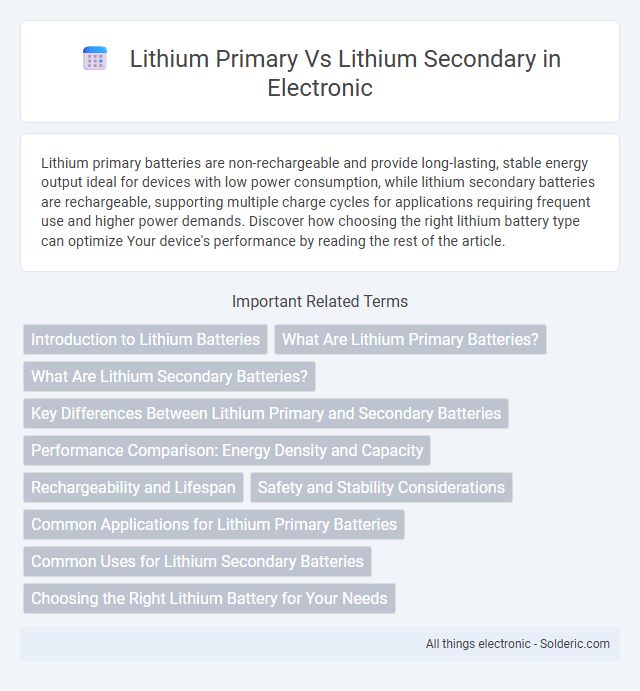Lithium primary batteries are non-rechargeable and provide long-lasting, stable energy output ideal for devices with low power consumption, while lithium secondary batteries are rechargeable, supporting multiple charge cycles for applications requiring frequent use and higher power demands. Discover how choosing the right lithium battery type can optimize Your device's performance by reading the rest of the article.
Comparison Table
| Feature | Lithium Primary Battery | Lithium Secondary Battery |
|---|---|---|
| Chemistry | Non-rechargeable lithium-based cells | Rechargeable lithium-ion or lithium-polymer cells |
| Rechargeability | No, single-use only | Yes, multiple recharge cycles |
| Voltage | 3.0V to 3.7V per cell | 3.6V to 3.7V per cell |
| Energy Density | High (150-300 Wh/kg) | Moderate to high (100-265 Wh/kg) |
| Applications | Remote controls, medical devices, watches, sensors | Smartphones, laptops, electric vehicles, power banks |
| Cost | Lower initial cost | Higher initial cost but cost-effective over lifespan |
| Self-discharge Rate | Very low | Low to moderate |
| Lifespan | Long shelf life (up to 10 years) | Limited cycle life (300-5000 cycles) |
| Environmental Impact | Single use, generates waste | Reusable, requires recycling |
Introduction to Lithium Batteries
Lithium primary batteries are single-use cells designed for long shelf life and high energy density, making them ideal for devices like remote controls and medical implants. Lithium secondary batteries, or rechargeable lithium-ion batteries, provide multiple charge cycles with stable performance, commonly powering smartphones, laptops, and electric vehicles. Your choice between primary and secondary lithium batteries depends on whether you need disposable convenience or long-term reusability.
What Are Lithium Primary Batteries?
Lithium primary batteries are non-rechargeable power sources that rely on lithium metal or lithium compounds as the anode, delivering high energy density and long shelf life ideal for devices like remote controls and medical implants. These batteries operate through irreversible chemical reactions, which means once depleted, they cannot be recharged or reused. Common types include lithium-thionyl chloride and lithium-manganese dioxide cells, known for their stable voltage output and reliable performance in extreme temperatures.
What Are Lithium Secondary Batteries?
Lithium secondary batteries, also known as rechargeable lithium-ion batteries, store and release energy through reversible chemical reactions involving lithium ions moving between the anode and cathode. These batteries offer high energy density, long cycle life, and rapid charging capabilities, making them ideal for portable electronics, electric vehicles, and renewable energy storage. Your choice between lithium primary and secondary batteries depends on whether you need a single-use power source or a rechargeable solution for ongoing use.
Key Differences Between Lithium Primary and Secondary Batteries
Lithium primary batteries are non-rechargeable cells designed for long shelf life and high energy density, commonly used in devices like remote controls and medical equipment. Lithium secondary batteries, or lithium-ion batteries, are rechargeable and widely utilized in smartphones, laptops, and electric vehicles due to their high energy efficiency and power output. Your choice between these two depends on whether you need disposable batteries for low-drain applications or rechargeable power sources for devices requiring frequent energy replenishment.
Performance Comparison: Energy Density and Capacity
Lithium primary batteries offer high energy density, making them ideal for long-term applications requiring stable power without recharge. Lithium secondary batteries provide superior overall capacity through rechargeable cycles, suitable for devices needing repeated energy delivery. Your choice depends on whether you prioritize one-time high energy output or sustainable cycling performance.
Rechargeability and Lifespan
Lithium primary batteries are non-rechargeable and designed for single-use applications, offering a longer shelf life and stable energy output but limited lifespan once discharged. Lithium secondary batteries, such as lithium-ion cells, are rechargeable and provide multiple charge-discharge cycles, extending operational lifespan significantly with proper maintenance. Rechargeability in lithium secondary cells makes them ideal for devices requiring consistent energy over time, whereas lithium primary batteries are preferred for low-drain or backup power scenarios due to their extended storage capability.
Safety and Stability Considerations
Lithium primary batteries offer high energy density and long shelf life but pose safety risks due to the inability to recharge, increasing the chance of leakage or explosion if mishandled. Lithium secondary batteries, or rechargeable lithium-ion cells, incorporate safety features like built-in protection circuits and thermal management systems to enhance stability during repeated charging cycles. Your choice should balance the need for safety with performance requirements, especially in applications where battery reliability is critical.
Common Applications for Lithium Primary Batteries
Lithium primary batteries are commonly used in applications requiring long shelf life and high energy density, such as medical devices, remote sensors, and military equipment. These batteries provide reliable power for smoke detectors, watches, and keyless entry systems due to their stable voltage and low self-discharge rates. Unlike lithium secondary batteries, lithium primary batteries are non-rechargeable and preferred for single-use, low-drain devices where replacement frequency is minimal.
Common Uses for Lithium Secondary Batteries
Lithium secondary batteries, also known as rechargeable lithium-ion batteries, are widely used in portable electronics such as smartphones, laptops, and tablets due to their high energy density and long cycle life. They are essential for electric vehicles (EVs), providing efficient energy storage and extended driving ranges that outperform traditional lead-acid or nickel-metal hydride batteries. Renewable energy storage systems increasingly rely on lithium secondary batteries to stabilize grid supply and support solar and wind power integration.
Choosing the Right Lithium Battery for Your Needs
Lithium primary batteries offer high energy density and long shelf life, making them ideal for low-drain or emergency devices like smoke detectors and medical equipment. Lithium secondary batteries are rechargeable, providing cost efficiency and sustainability for high-drain applications such as smartphones, electric vehicles, and power tools. Selecting the right lithium battery depends on usage frequency, device power demands, and whether rechargeability or extended storage life is a priority.
Lithium primary vs lithium secondary Infographic

 solderic.com
solderic.com